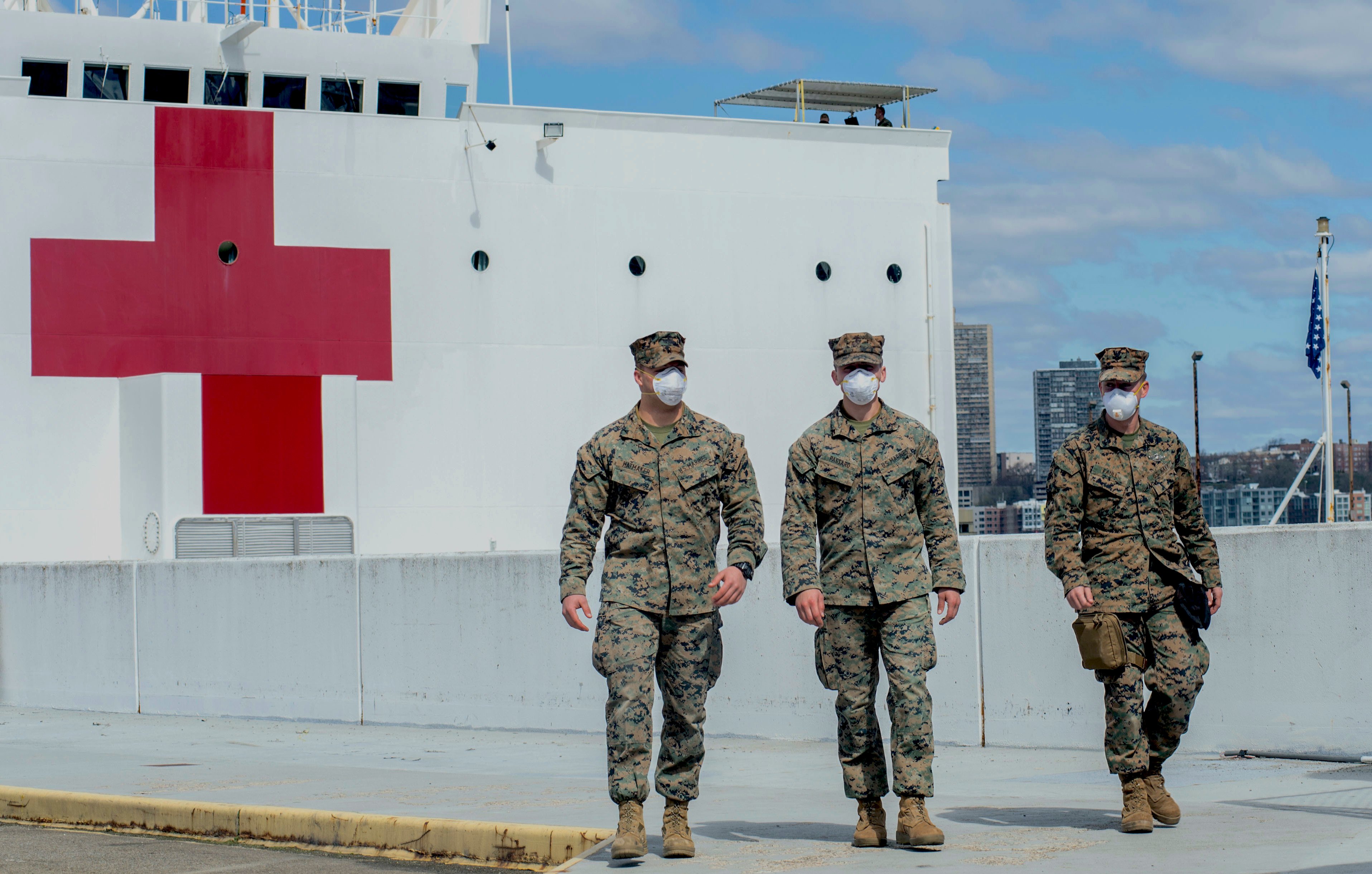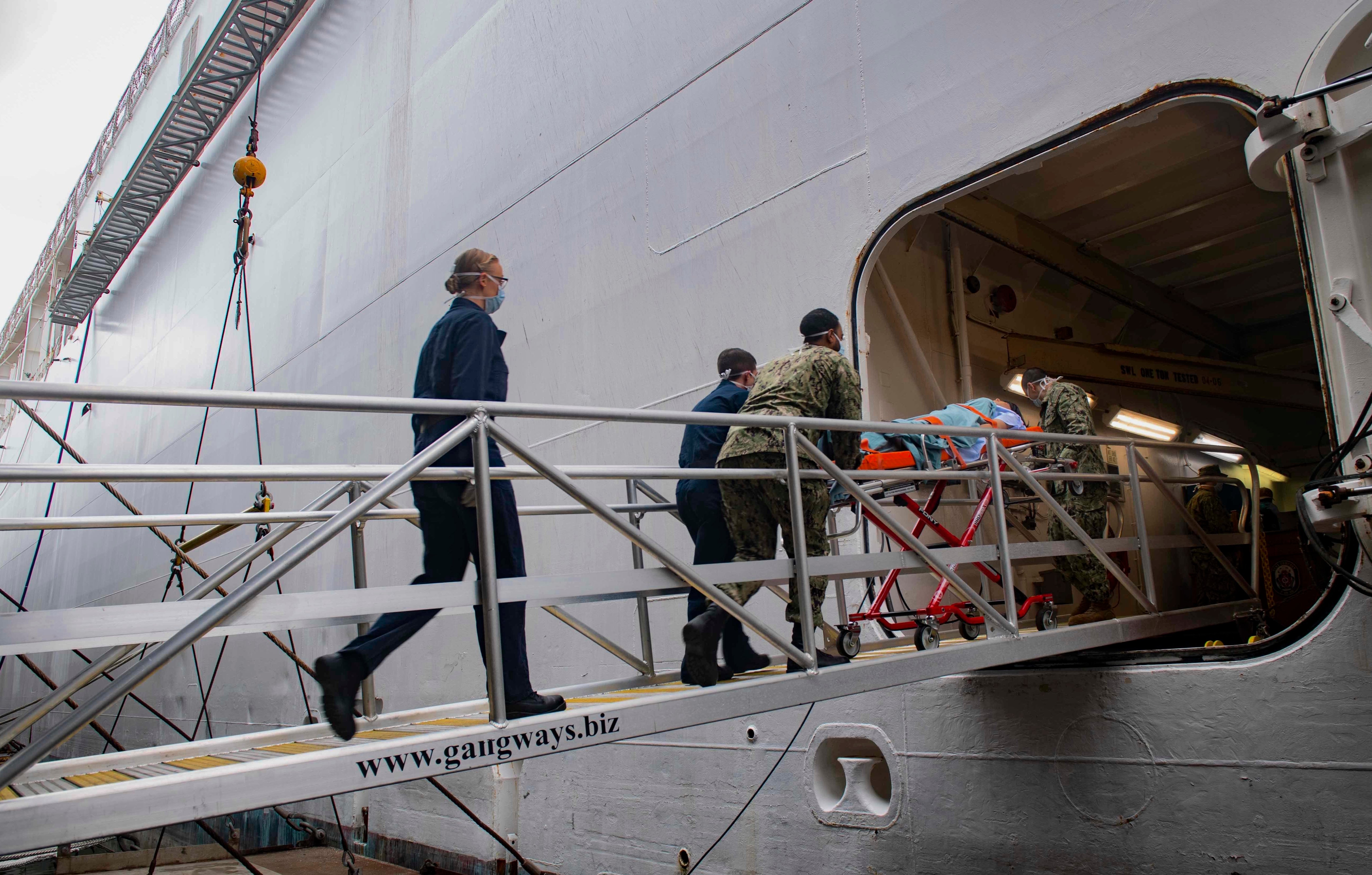
This post has been updated with additional information about five COVID-19 patients who were transferred to USNS Comfort on Saturday.
After public criticism flared late Thursday that USNS Comfort (T-AH-20) was treating too few patients while New York City hospitals grapple with COVID-19 cases, defense officials on Friday agreed to ease requirements for patients treated by the 1,000-bed hospital ship.
The initial arrangement by federal and local authorities required patients first be screened and tested for the virus by a local hospital before they could be transported to Comfort, which caused a backlog at some hospitals. Instead, patients now are screened by temperature and a short questionnaire pier-side, the Defense Department announced.
“Ambulances will now go directly to the Comfort instead of heading to a hospital for screening,” Jonathan Hoffman, the chief Pentagon spokesman, said during an afternoon press conference at the Pentagon.
That procedural change, however, leaves open the possibility that patients not exhibiting COVID-19 symptoms might actually be infected. Fox News reported Saturday that “less than five” patients ambulances brought aboard Friday had swab tests done during screening that later were then found positive for COVID-19. On Saturday, those patients were taken off the ship and returned to the makeshift Army hospital set up at the Jacob Javits Convention Center.
A U.S. 2nd Fleet spokeswoman confirmed to USNI News that “a few patients tested positive” for coronavirus. “The patients were isolated immediately upon arrival and received care for the entirety of their time aboard the ship, and were transferred as soon as practical to the Javits Center,” said Lt. Marycate Walsh in New York City. While no longer requiring a negative COVID-19 test before patients can be broad to Comfort, “we are now accepting asymptomatic, screened patients who will be isolated and tested immediately upon arrival.”
Military and medical officials have said procedures were in place to handle such cases to prevent the spread aboard ship. “
Our medical experts on board are well prepared for cases like this and have taken the appropriate precautionary measures,” Walsh said.
That includes infection-control procedures that are the same as civilian hospitals and the use of personal protective equipment by Comfort personnel. “The areas where all patients have been are thoroughly cleaned, before patients arrive, during their stay and upon departure,” Walsh said, adding “we are taking every precaution to prevent the spread of COVID-19.”
Comfort this week berthed at Pier 90, one of the city’s cruise terminals along the Hudson River. The hospital ship – along with sister ship USNS Mercy (T-AH-19) that’s deployed to Los Angeles as part of the military’s support to the federal response – are staffed, equipped and organized to treat non-COVID-19 infected patients to help ease local hospitals’ caseloads of treating non-COVID-19 trauma patients.
News and social media posts that just two days ago heralded Comfort’s arrival in Manhattan turned scathing after the senior medical officer aboard, in an Pentagon press briefing, that three patients were brought onto the ship in the first day and more patients likely would arrive in the coming days. (Navy officials late Thursday said the count was up to 20.)
The Navy had rushed Comfort to New York from Norfolk, Va., where the ship departed March 28 after an interrupted maintenance period. “We believe we are early to need at this time, but anticipate the usage will grow in the coming days,” Hoffman said.
In New York, Comfort is plugged into the city’s hospital and ambulance network. By eliminating the initial requirement for a COVID-19 test result, “now the ambulance takes people straight to the Comfort, so we believe that will increase the numbers.”
While the expectation was to treat trauma patients, and relieve that burden on local hospitals, regional shelter-in-place orders by local and state officials have led to fewer trauma cases, such as vehicle accidents and assaults, on a daily basis. “Hospitals have not seen that demand as much,” Hoffman said. “Do we expect to see that go up? Yes. We do not believe we are at the peak in New York by any stretch. We expect that will go up in the coming days.”
The dearth of initial caseload also prompted increased calls for the military to allow treatment of COVID-19 patients on the ships, as some local emergency facilities have begun to do.
“With the Comfort and the Mercy, it’s something we are looking at,” Hoffman said, adding that “we are very well aware of the risks in doing that. We’ve all seen what happens on some of the ships,” such as the cruise ships.
“It’s not an environment built for handling infectious diseases,” he said. “So our concerns are a couple: One, keeping the spread from non-COVID infected patients on the ship. That would be very difficult. Two, our expectation has always been that these Comfort and the Mercy would go to the areas of greatest need, and then as the wave passes… that maybe the Comfort and the Mercy are needed somewhere else. Maybe they are needed in Miami or New Orleans or somewhere else on the East Coast, and maybe the Mercy is needed somewhere else.
“If we open it up to COVID patients, the likelihood of infection of our doctors goes up. We’re aware of that risk and taking it into account,” he added. “The likelihood of having to empty the ship out at some point and do an extensive, deep cleaning that could take days or longer goes up, and therefore that may reduce our ability to use it in the future. All of that is being looked at.”

Hoffman said officials were optimistic that test kits that can quickly determine whether a patient is infected with COVID-19 would speed up the screening and processing of trauma patients brought to the ships and field hospitals and community treatment centers also handling COVID-19 patients. “We’ll be looking at that as it comes online in the coming days,” he said.
The Defense Department is taking guidance on the assignment of its medical resources from FEMA and the Department of Health and Human Services, which are working with state and local officials to determine “where our resources would do the best good,” Hoffman said. “Our hope is that we’ll be able to move people around, and that we’ll be able to go from one community to the next” if needs change. U.S. Northern Command is leading the COVID-19 support to civil health authorities.
Also on Friday, the Defense Department agreed to a FEMA request to expand its medical support to include support patients who test positive for the COVID-19 virus at three locations: at New York City’s Jacob Javits Convention Center, Morial Federal Medical Station (FMS) in New Orleans, La., and Kay Bailey Hutchinson FMS in Dallas, Texas.
Navy expeditionary medical facilities, or EMF, “were in the process of deploying to New Orleans and Dallas and would be fully operational in the next couple of days,” Hoffman said. The military deployed more than 400 doctors, 1,000 nurses and 60 respiratory therapists to those locations, and “we have another 350 doctors, 500 nurses and almost 100 respiratory therapists that are on the way.”
Those personnel are from active-duty units in the Navy, Army and Air Force, but “we’ve begun to put reserve units on notice that they may be necessary,” he said, adding that volunteers might be sought from the reserves and the Guard.





